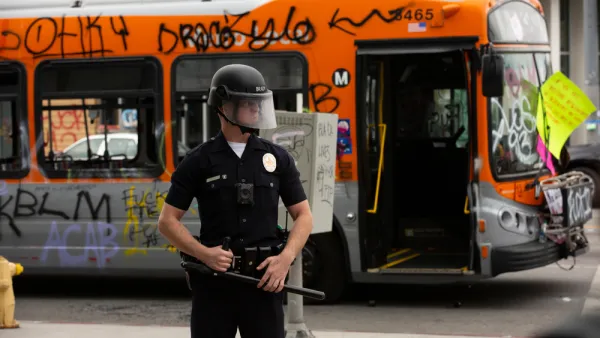From London to Los Angeles, the punk movement was always an urban phenomenon. But punks needed to fight hard for a place in the cities they called home.

Punk's not dead, but these days it may have more to fear from gentrifiers than the police. Jamie Thomson writes, "As a host of cultural historians will attest, punk never died, it just went underground. Mutating into hardcore, it retreated to the basements, the garages and the backstreet dives – but like a weed pushing through the cracks, it has fought to find its place in the hostile environment of the modern city."
As punk came up, police crackdowns weren't the only issue. "For the scene to survive, hardcore bands needed places to play – and in venues free from intervention by authority figures or age restrictions (in the US, the drinking age of 21 would exclude a good 80% of the audience)."
While London was always a punk capital, a dedicated art space took along time to coalesce. "It's somewhat surprising, then, that London has taken so long to establish its own autonomous space – and it was only due to the efforts of a small group that, in 2015, DIY Space for London was established."
These days, the punk ethos thrives online, while it's more muted on gentrifying urban streets. But it has also spread to new places like Japan and Indonesia.
FULL STORY: How punk changed cities – and vice versa

National Parks Layoffs Will Cause Communities to Lose Billions
Thousands of essential park workers were laid off this week, just before the busy spring break season.

Retro-silient?: America’s First “Eco-burb,” The Woodlands Turns 50
A master-planned community north of Houston offers lessons on green infrastructure and resilient design, but falls short of its founder’s lofty affordability and walkability goals.

Delivering for America Plan Will Downgrade Mail Service in at Least 49.5 Percent of Zip Codes
Republican and Democrat lawmakers criticize the plan for its disproportionate negative impact on rural communities.

Test News Post 1
This is a summary

Test News Headline 46
Test for the image on the front page.

Balancing Bombs and Butterflies: How the National Guard Protects a Rare Species
The National Guard at Fort Indiantown Gap uses GIS technology and land management strategies to balance military training with conservation efforts, ensuring the survival of the rare eastern regal fritillary butterfly.
Urban Design for Planners 1: Software Tools
This six-course series explores essential urban design concepts using open source software and equips planners with the tools they need to participate fully in the urban design process.
Planning for Universal Design
Learn the tools for implementing Universal Design in planning regulations.
EMC Planning Group, Inc.
Planetizen
Planetizen
Mpact (formerly Rail~Volution)
Great Falls Development Authority, Inc.
HUDs Office of Policy Development and Research
NYU Wagner Graduate School of Public Service





























